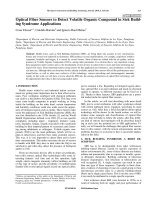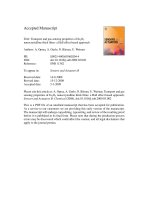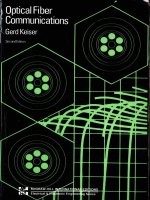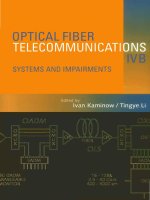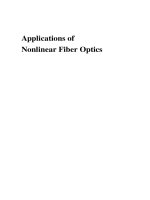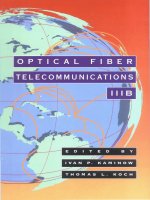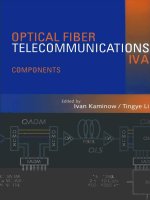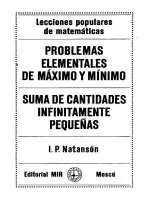kaminow, i. p. (2001). optical fiber telecommunications iv-b
Bạn đang xem bản rút gọn của tài liệu. Xem và tải ngay bản đầy đủ của tài liệu tại đây (27.67 MB, 1,050 trang )
OPTICAL
FIBER
TE
LE
C
0
M
M
U
N
I
CAT
I
SYSTEMS
AND
IMPAIRMENTS
OPTICAL FIBER
TELECOMMUNICATIONS
IV
B
SYSTEMS AND IMPAIRMENTS
OPTICAL FIBER
TELECOMMUNICATIONS
IV
B
SYSTEMS
AND
IMPAIRMENTS
Edited
by
IVAN
P.
KAMINOW
Bell Laboratories (retired)
Kaminow Lightwave Technology
Holmdel, New Jersey
TINGYE
LI
AT&T
Labs (retired)
Boulder, Colorado
ACADEMIC
PRESS
An Elsevier Science
Imprint
San
Diego
San Francisco
New
York
Boston London Sydney
Tokyo
This
book
is
printed
on
acid-free paper.
@
Copyright
@
2002, Elsevier Science (USA).
All
rights reserved.
No part of this publication may be reproduced or transmitted in any form or by any means,
electronic or mechanical, including photocopy, recording, or any information storage and
retrieval system, without permission in writing from the publisher.
The appearance of the code at the bottom
of
the hst page of
a
chapter in this book indicates the
Publisher’s consent that copies of the chapter may be made for personal or internal
use
of
speci6c clients. This consent is given on the condition, however, that the copier pay the stated
per copy fee through the Copyright Clearance Center, Inc. (222 Rosewood Drive, Danvers,
Massachusetts 01923), for copying beyond that permitted by Sections 107 or 108 of the
U.S.
Copyright Law. This consent does not extend to other kinds of copying, such as copying for
general distribution, for advertising or promotional purposes, for creating new collective works,
or for resale. Copy
fees
for pre-2001 chapters are
as
shown on the title pages. If no fee code
appears on the title page, the copy fee is the same as for current chapters. $35.00.
Academic Press
An
Elsevier
Science
Imprint
525
B
Street, Suite 1900, San Diego, California 92101-4495,
USA
Academic Press
Harcourt
Place, 32 Jamestown
Road,
London NW17BY,
UK
Library of Congress Control Number: 2001098830
International Standard Book Number: 0-12-395173-9
PRINTED
IN
CHINA
02
03
04
05
06
07 RDC 9
8
7
6
5
4
3
2
1
For Florence
and Edith, with
love
Contents
Contributors
xi
Chapter
1
Overview
Ivan
19
Kaminow
Chapter
2
Growth
of
the Internet
Kerry
G.
Coflman and Andrew M. Odbzko
Chapter
3
Optical Network Architecture Evolution
John Strand
Chapter
4
Undersea Communication Systems
Neal
S.
Bergano
Chapter
5
High-Capacity, Ultra-Long-Haul Networks
John Zyskind, Rick Bany, Graeme Pendock, Michael Cahill, and
Jinendra Ranka
1
17
57
154
198
Chapter
6
Pseudo-Linear Transmission
of
High-speed TDM
Signals: 40 and 160
Gb/s
Red-Jean Essiambre, Gregory Raybon, and Benny Mikkelsen
232
vii
viii
Contents
Chapter
7
Dispersion-Managed Solitons and Chirped Return to
Zero: What
Is
the Difference?
305
Curtis R. Menyuk, Gary
M.
Carter; William L. Kath, and
Ruo-Mei Mu
Chapter
8
Metropolitan Optical Networks
Nasir Ghani, Jin-B Pan, and Xin Cheng
Chapter
9
The Evolution
of
Cable
TV
Networks
Xiaolin Lu and OIeh Sneizka
Chapter
10
Optical Access Networks
Edward Harstead and Pieter H. van Heyningen
329
404
438
Chapter
11
Beyond Gigabit: Application and Development
of
High-speed Ethernet Technology
514
Cedric
E
Lam
Chapter
12
Photonic Simulation Tools
Arthur
J.
Lowery
Chapter
13
Nonlinear Optical Effects in WDM Transmission
Polina Bayvel and Robert Killey
564
61
1
Chapter
14
Fixed and Tunable Management
of
Fiber Chromatic
Dispersion
642
Alan
E.
Willner and Bogdan Hoanca
Chapter
15
Polarization-Mode Dispersion
Herwig Kogelnik, Robert
M.
Jopson, and Lynn
E.
Nelson
725
Contents
ix
Chapter
16
Bandwidth-Efficient Modulation Formats for
Digital Fiber Transmission Systems 862
Jan Conradi
Chapter
17
Error-Control Coding Techniques
and
Applications
902
E!
Vjay
Kumar,
Moe
Z.
Win, Hsiao-Feng
Lu,
and
Costas
N.
Georghiades
Chapter
18
Equalization Techniques for Mitigating Transmission
Impairments 965
Moe
Z.
Win, Jack H. Winters, and Giorgio M. Etetta
Index to Volumes IVA and
IVB
999
Contributors
D. A. Ackerman
(A:587), Agere Systems, 600 Mountain Avenue, Murray Hill,
Daniel Y. Al-Salameh
(A295), JDS Uniphase Corporation, 100 Willowbrook
Rick Barry
(B: 198), Sycamore Networks, 10 Elizabeth Drive, Chelmsford,
Polina Bayvel
(B:61 l), Optical Networks Group, Department of Elec-
tronic and Electrical Engineering, University College London (UCL),
Torrington Place, London WCl E 7JE, United Kingdom
Neal
S.
Bergano
(B: 154), Tyco Telecommunications, 250 Industrial Way West,
Eatontown, New Jersey 07724-2206
Lee
L.
Blyler
(A:17), OFS Fitel, LLC, 600 Mountain Avenue, Murray Hill,
New Jersey 07974
Raymond
K.
Boncek
(A: 17), OFS Fitel, LLC, 600 Mountain Avenue, Murray
Hill, New Jersey 07974
Michael Cahil
(B: 198), Sycamore Networks, 10 Elizabeth Drive, Chelmsford,
Massachusetts 01824-41 11
Gary
M.
Carter
(B:305), Computer Science and Electrical Engineering
Department, TRC-20
1
A, University of Maryland Baltimore County,
1000 Hilltop Circle, Baltimore, Maryland 21250 and Laboratory for
Physical Sciences, College Park, Maryland
Connie
J.
Chang-Hasnain
(A:666), Department
of
Electrical Engineering and
Computer Science, University of California, Berkeley, California 94720
and Bandwidth 9 Inc., 46410 Fremont Boulevard, Fremont, California
94538
Young-Kai Chen
(A:784), Lucent Technologies, High Speed Electronics
Research, 600 Mountain Avenue, Murray Hill, New Jersey 07974
Xin Cheng
(B:329), Sorrento Networks Inc., 9990 Mesa Rim Drive, San Diego,
California 921
2
1-2930
New Jersey 07974
Road, Bldg. 1
,
Freehold, New Jersey 07728-2879
Massachusetts
01
824-41 11
xi
xu
Contributors
Dominique Chiaroni
(A:732), Alcatel Research
&
Innovation, Route de Nozay,
F-9 146
1
Marcoussis cedex, France
Kerry G. Coffman
(B:17), AT&T Labs-Research, A5-1D03, 200 Laurel
Avenue South, Middletown, New Jersey 07748
Jan Conradi
(B:862), Director of Strategy, Corning Optical Communications,
Corning Incorporated, MP-HQ-Wl-43, One River Front Plaza, Corning,
New York 14831
Santanu
JL
Das
(A: 17), OFS Fitel, LLC, 600 Mountain Avenue, Murray Hill,
Emmanuel Desurvire
(A:732), Alcatel Technical Academy, Villarceaux,
David J. DiGiovanni
(A:17), OFS Fitel, LLC, 600 Mountain Avenue, Murray
Christopher
R
Doerr
(A:405), Bell Laboratories, Lucent Technologies, 791
Adam Ellison
(A:80), Corning,
Inc.,
SP-FR-05, Corning, New York 14831
L.
E. Eng
(A:587), Agere Systems, Room 2F-204, 9999 Hamilton Blvd.,
Breinigsville, Pennsylvania 1803 1-9304
Turan Erdogan
(A:477), Semrock, Inc., 3625 Buffalo Road, Rochester,
New York 14624
RenkJean Essiambre
(B:232), Bell Laboratories, Lucent Technologies, 79 1
Holmdel-Keyport Road, Holmdel, New Jersey 07733
Costas
N.
Georghiades
(B:902), Texas A&M University, Electrical Engineer-
ing Department, 237 Wisenbaker, College Station, Texas 77843-3 128
Nasir Ghani
(B:329), Sorrento Networks Inc., 9990 Mesa Rim Drive,
San
Diego, California 92121-2930
Steven
E.
Golowich
(A: 17), Bell Laboratories, Lucent Technologies, Room
2C-357,600 Mountain Avenue, Murray Hill, New Jersey 07974
Christoph
S.
Harder
(A:563), Nortel Networks Optical Components,
Binzstrasse 17, CH-8045 Zurich, Switzerland
Edward Harstead
(B:438), Bell Laboratories, Lucent Technologies, 101
Crawford Corners Road, Holmdel, New Jersey 07733
Bogdan Hoanca
(B:642), Phaethon Communications,
Inc.,
Fremont,
California 96538
New Jersey 07974
F-9 1625 Nozay cedex, France
Hill, New Jersey 07974
Holmdel-Keyport Road, Holmdel, New Jersey 07733
Contributors
xiii
J.
E.
Johnson
(A587), Agere Systems, 600 Mountain Avenue, Murray Hill,
New Jersey 07974
Robert
M.
Jopson
(B:725), Crawford Hill Laboratory, Bell Laboratories,
Lucent Technologies, 79 1 Holmdel-Keyport Road, Holmdel, New Jersey
07733
Ivan
P.
Kaminow
(A:
1
,
B: l), Bell Laboratories (retired), Kaminow Lightwave
Technology, 12 Stonehenge Drive, Holmdel, New Jersey 07733
Bryon
L.
Kasper
(A:784), Agere Systems, Advanced Development Group,
4920 Rivergrade Road, Irwindale, California 91 706-1404
William L. Kath
(B:305), Computer Science and Electrical Engineering
Department, University of Maryland Baltimore County, 1000 Hilltop
Circle, Baltimore, Maryland 21250 and Applied Mathematics Depart-
ment, Northwestern University, 2145 Sheridan Road, Evanston, Illinois
L. J.
P.
Ketelsen
(A:587), Agere Systems, 600 Mountain Avenue, Murray Hill,
New Jersey 07974
P.
A.
Kiely
(A:587), Agere Systems, 9999 Hamilton Blvd., Breinigsville,
Pennsylvania 1803 1-9304
Robert Killey
(B:61 l), Optical Networks Group, Department of Elec-
tronic and Electrical Engineering, University College London (UCL),
Torrington Place, London WClE 7JE, United Kingdom
Herwig Kogelnik
(B:725), Crawford Hill Laboratory, Bell Laboratories,
Lucent Technologies, 79 1 Holmdel-Keyport Road, Holmdel, New Jersey
07733
Steven
K
Korotky
(A295), Bell Laboratories, Lucent Technologies, Room HO
3C-351,101 Crawfords Corner Road, Holmdel, New Jersey 07733-1900
P.
Mjay Kumar
(B:902), Communication Science Institute, Department of
Electrical Engineering
-
Systems, University of Southern California, 3740
McClintock Avenue, EEBSOO, Los Angeles, California 90089-2565 and
Scintera Networks, Inc.,
San
Diego, California
Cedric
E
Lam
(B:514), AT&T Labs-Research, 200 Laurel Avenue South,
Middletown,
New
Jersey
07748
Bruno Lavigne
(A:732), Alcatel CIT/ Research
&
Innovation, Route de Nozay,
F-91461 Marcoussis cedex, France
Olivier Leclerc
(A732), Alcatel Research
&
Innovation, Route de Nozay,
F-91460 Marcoussis cedex, France
60208-3125
xiv Contributors
David
S.
Levy
(A295), Bell Laboratories, Lucent Technologies, Room HO
3B-506, 101 Crawfords Corner Road, Holmdel, New Jersey 07733-3030
Arthur
J.
Lowery
(B:564), VPIsystems Inc., Design Center Group, 17-27
Cotham Road, Kew, Melbourne 3101, Australia
Xiaolin Lu
(B:404), Morning Forest, LLC, 8804 S. Blue Mountain Place,
Highlands Ranch, Colorado 80126
Hsiao-Feng Lu
(B:902), Communication Science Institute, Department of
Electrical Engineering
-
Systems, University of Southern California, 3740
McClintock Avenue, EEBSOO, Los Angeles, California 90089-2565
Amaresh Mahapatra
(A:258), Linden Corp., 10 Northbriar Road, Acton,
Massachusetts 01720
T.
G. B. Mason
(A:587), Agere Systems, 9999 Hamilton Blvd., Breinigsville,
Pennsylvania 1803 1-9304
Curtis
R.
Menyuk
(B:305), Computer Science and Electrical Engineering
Department, TRC-20 1 A, University of Maryland Baltimore County
1000 Hilltop Circle, Baltimore, Maryland 21250 and PhotonEx Cor-
poration, 200 MetroWest Technology Park, Maynard, Massachusetts
0
1754
Benny Mikkelsen
(B:232), Mintera Corporation, 847 Rogers Street, One
Lowell Research Center, Lowell, Massachusetts 01 852
John Minelly
(A:80), Corning, Inc., SP-AR-02-01, Corning, New York 14831
Osamu Muuhara
(A:784), Agere Systems, Optical Systems Research, 9999
Hamilton Blvd., Breinigsville, Pennsylvania 1803 1
Stefan Mohrdiek
(A:563), Nortel Networks Optical Components, Binzstrasse
17, CH-8045 Ziirich, Switzerland
Ruo-Mei Mu
(B:305), Tyco Telecommunications, 250 Industrial Way West,
Eatontown, New Jersey 07724-2206
Edmond
J.
Murphy
(A:258),
JDS
Uniphase, 1985 Blue Hills Avenue Ext.,
Windsor, Connecticut 06095
Timothy
0.
Murphy
(A:295), Bell Laboratories, Lucent Technologies, Room
HO 3D-516, 101 Crawfords Corner Road, Holmdel, New Jersey 07733-
3030
Lynn
E.
Nelson
(B:725),
OFS
Fitel, Holmdel, New Jersey 07733
Andrew M. Odlyzko
(B:17), University of Minnesota Digital Technology
Center, 1200 Washington Avenue
S.,
Minneapolis, Minnesota 5541 5
Contributors xv
Jin-Yi Pan
(B:329), Sorrento Networks Inc., 9990 Mesa Rim Drive, San Diego,
California 92121 -2930
Sunita
18.
Pate1
(A:295), Bell Laboratories, Lucent Technologies, Room
HO
3D-502,101 Crawfords Comer Road, Holmdel, New Jersey 07733-3030
Graeme Pendock
(B: 198), Sycamore Networks, 10 Elizabeth Drive, Chelms-
ford, Massachusetts 01824-41 11
Jinendra Ranka
(B: 198), Sycamore Networks, 10 Elizabeth Drive, Chelms-
ford, Massachusetts 01824-41 11
Gregory Raybon
(B:232), Bell Laboratories, Lucent Technologies, 79 1
Holmdel-Keyport Road, Holmdel, New Jersey 07733
Gaylord
W.
Richards
(A:295), Bell Laboratories, Lucent Technologies, Room
6L-219,2000 Naperville Road, Naperville, Illinois 60566-7033
Karsten Rottwitt
(A:213), Orsted Laboratory, Niels Bohr Institute, University
of Copenhagen, Universitetsparken 5, Copenhagen dk
2
100, Denmark
Bertold
E.
Schmidt
(A: 563), Nortel Networks Optical Components, Binzs-
trasse 17, Ch-8045 Zurich, Switzerland
Oleh Sniezko
(B:404), Oleh-Lightcom, Highlands Ranch, Colorado 801 26
Leo H. Spiekman
(A:699), Genoa Corporation, Lodewijkstraat 1 A, 5652 AC
Atul
K.
Srivastava
(A:174), Onetta Inc., 1195 Borregas Avenue, Sunnyvale,
Andrew
J.
Stentz
(A:213), Photuris, Inc.,
20
Corporate Place South,
Piscataway, New Jersey 08809
John Strand
(B:57), AT&T Laboratories, Lightwave Networks Research
Department, RoomA5-106,200 Laurel Avenue, Middletown, New Jersey
07748
Thomas
A.
Strassser
(A:477), Photuris Inc.,
20
Corporate Place South,
Yan Sun
(A:174), Onetta Inc., 1195 Borregas Avenue, Sunnyvale, California
Eric
S.
Tentarelli
(A:295), Bell Laboratories, Lucent Technologies, Room
HO
3B-530,101 Crawfords Corner Road, Holmdel, New Jersey 07733-3030
Pieter
H.
van Heyningen
(B:438), Lucent Technologies
NL,
PO.
Box
18,
Huizen 1270AA, The Netherlands
Eindhoven, The Netherlands
California 94089
Piscataway, New Jersey 08854
94089
xvi
Contributors
Giorgio
M.
Vitetta
(B:965), University of Modena and Reggio Emilia, Depart-
ment
of
Information Engineering, Via Vignolese 905, Modena 41100,
Italy
W. White
(A:17),
OFS
Fitel, LLC, 600 Mountain Avenue, Murray Hill, New
Jersey 07974
Alan
E.
Willner
(B:642), University
of
Southern California, Los Angeles,
California 90089-2565
Moe Z. Win
(B:902, B:965), AT&T Labs-Research, Room A5-1D01,
200
Laurel Avenue
South,
Middletown, New Jersey 07748-1914
Jack
H.
Winters
(B:965), AT&T Labs-Research, Room 4-147, 100 Schulz
Drive, Middletown, New Jersey 07748- 19 14
Martin Zirngibl
(A:374), Bell Laboratories, Lucent Technologies, 79
1
Holmdel-Keyport Road, Holmdel, New Jersey 07733-0400
John Zyskind
(B: 198), Sycamore Networks, 10 Elizabeth Drive, Chelmsford,
Massachusetts
0
1824-41 1 1
Ivan
P.
Kaminow
Bell Laboratories
(retired),
Kaminow Lightwave Technology, Holmdel,
New
Jerscy
Introduction
Modern lightwave communications had its origin
in
the first demonstrations
of the laser in 1960. Most
of
the early lightwave R&D was pursued by estab-
lished telecommunications company labs (AT&T, NTT, and the British Post
Office among them).
By
1979, enough progress had been made in light-
wave technology to warrant a book,
Optical Fiber Telecommunications (OFlJ,
edited by
S.
E. Miller and A.
G.
Chynoweth, summarizing the state of the
art. Two sequels have appeared: in 1988,
OFT
11,
edited by
S.
E. Miller and
I.
P.
Kaminow, and in 1997,
OFT
111
(A
&
B),
edited by
I.
P. Kaminow and
T.
L.
Koch. The rapid changes in the field now call for a fourth set of books,
OFTW
(A
&
B).
This chapter briefly summarizes the previous books and chronicles the
remarkably changing climates associated with each period of their publica-
tion. The main purpose, however, is to summarize the chapters in
OFT
IV
in
order to give the reader an overview.
History
While many excellent books on lightwave communications have been pub-
lished, this series has developed a special character, with a reputation for
comprehensiveness and authority, because
of
its unique history.
Optical Fiber
Telecommunications
was published in 1979, at the dawn
of
the revolution
in lightwave telecommunications. It was a stand-alone work that aimed to
collect all available information
on
lightwave research. Miller was Director
of the Lightwave Systems Research Laboratory and, together with Rudi
Kompfner, the Associate Executive Director, guided the system research at
the Crawford Hill Laboratory of AT&T Bell Laboratories; Chynoweth was
an Executive Director in the Murray Hill Laboratory, leading the optical
fiber research. Many groups were active at other laboratories in the United
States, Europe, and Japan.
OFT,
however, was written exclusively by Bell
Laboratories authors, who nevertheless aimed to incorporate global results.
1
OPTICAL FIBER TELECOMMUNICATIONS,
VOLUME
IVB
Copyright
0
2002,
Elsevier
Science
(USA).
All
rights
of
reproduction
in
any
form
reserved.
ISBN
0-12-395173-9
2
Ivan
P.
Kaminow
Miller and Chynoweth had little trouble finding suitable chapter authors at
Bell Labs to cover practically all the relevant aspects of the field at that time.
Looking back at that volume, it is interesting that the topics selected
are still quite basic. Most of the chapters cover the theory, materials, mea-
surement techniques, and properties of fibers and cables (for the most part,
multimode fibers). Only one chapter covers optical sources, mainly multi-
mode AlGaAs lasers operating in the
800-
to
900-nm
band. The remaining
chapters cover direct and external modulation techniques, photodetectors and
receiver design, and system design and applications Still, the basic elements
of the present day systems are discussed: low-loss vapor-phase silica fiber and
double-heterostructure lasers.
Although system trials were initiated around
1979,
it required several more
years before a commercially attractive lightwave telecommunications system
was installed in the United States. The AT&T Northeast Corridor System,
operating between New York and Washington,
DC,
began service in January
1983,
operating at a wavelength of
820
nm and a bit rate
of
45
Mb/s in multi-
mode fiber. Lightwave systems were upgraded in
1984
to
1310nm
and
417
or
560
Mb/s in single-mode fiber in the United States as well as in Europe and
Japan.
The year
1984
also saw the Bell System broken up by the court-imposed
“Modified Final Judgment” that separated the Bell operating companies into
seven regional companies and left AT&T as the long distance camer
as
well as
a telephone equipment vendor. Bell Laboratories remained with AT&T, and
Bellcore was formed to serve as the
R&D
lab for all seven regional Bell operat-
ing companies (RBOCs). The breakup spurred a rise in diversity and competi-
tion in the communications business. The combination of technical advances
in computers and communications, growing government deregulation, and
apparent new business opportunities all served to raise expectations.
Tremendous technical progress was made during the next few years, and the
choice of lightwave over copper coaxial cable or microwave relay for most long-
haul transmission systems was assured. The goal of research was to improve
performance, such as bitrate and repeater spacing, and to find other applica-
tions beyond point-to-point long haul telephone transmission. A completely
new book,
Optical Fiber Telecommunications
11,
was published in
1988
to sum-
marize the lightwave
R&D
advances at the time.
To
broaden the coverage, non-
Bell Laboratories authors from Bellcore (now Telcordia), Corning, Nippon
Electric Corporation, and several universities were represented among the
contributors. Although research results are described in
OFT
11,
the emphasis
is much stronger
on
commercial applications than in the previous volume.
The initial chapters of
OFT
11
cover fibers, cables, and connectors, deal-
ing with both single- and multimode fiber. Topics include vapor-phase
methods for fabricating low-loss fiber operating at
13
10
and
1550
nm,
understanding chromatic dispersion and nonlinear effects, and designing
polarization-maintaining fiber. Another large group of chapters deals with
1.Overview
3
a range of systems for loop, intercity, interoffice, and undersea applications.
A research-oriented chapter deals with coherent systems and another with
possible local area network designs, including a comparison of time-division
multiplexing (TDM) and wavelength division multiplexing (WDM) to effi-
ciently utilize the fiber bandwidth. Several chapters cover practical subsystem
components, such as receivers and transmitters and their reliability. Other
chapters cover photonic devices, such as lasers, photodiodes, modulators, and
integrated electronic and integrated optic circuits that make up the subsys-
tems.
In
particular, epitaxial growth methods for
InGaAsP
materials suitable
for 13 10 and 1550 nm applications and the design of high-speed single-mode
lasers are discussed in these chapters.
By 1995, it was clear that the time had arrived to plan for a new volume
to address recent research advances and the maturing of lightwave systems.
The contrast with the research and business climates of 1979 was dramatic.
Sophisticated system experiments were being performed utilizing the commer-
cial and research components developed for a proven multibillion-dollar global
lightwave industry. For example, 10,000-km lengths of high-performance fiber
were assembled in several laboratories around the world for nonreturn-to-zero
(NRZ), soliton, and WDM transmission demonstrations. Worldwide regula-
tory relief stimulated the competition in both the service and hardware ends
of the telecommunications business. The success in the long-haul market and
the availability of relatively inexpensive components led to a wider quest for
other lightwave applications in cable television and local access network mar-
kets. The development of the diode-pumped, erbium-doped fiber amplifier
(EDFA) played a crucial role in enhancing the feasibility and performance of
long-distance and WDM applications. By the time of publication of
OFT
111
in 1997, incumbent telephone companies no longer dominated the industry.
New companies were offering components and systems and other startups
were providing regional, exchange, and Internet services.
In 1996, AT&Tvoluntarily separated its long distance service and telephone
equipment businesses to better meet the competition. The former kept the
AT&T name, and the latter took on the name Lucent Technologies. Bell Labs
remained with Lucent, and AT&T Labs was formed. Bellcore was put up for
sale, as the consolidating and competing RBOCs found they did not need a
joint lab.
Because
of
a wealth of new information,
OFTIII
was divided into two books,
A
and
B,
covering systems and components, respectively. Many topics of the
previous volumes, such as fibers, cables, and laser sources, are updated. But a
much larger list of topics covers fields not previously included. In
A,
for exam-
ple, transceiver design,
EDFAs,
laser sources, optical fiber components, planar
(silica on silicon) integrated circuits, lithium niobate devices, and photonic
switching are reviewed. And in
By
SONET (synchronous optical network)
standards, fiber and cable design, fiber nonlinearities, polarization effects,
solitons, terrestrial and undersea systems, high bitrate transmission, analog
4
Ivan
P.
Kaminow
cable systems, passive optical networks (PONS), and multiaccess networks
are
covered.
Throughout the two books, erbium amplifiers and WDM are common
themes. It is difficult to overstate the impact these two technologies have had
in both generating and supporting the telecommunications revolution that
coincided with their commercial introduction. The EDFA was first reported in
about
1987
by researchers at Southampton University
in
the UK and at AT&T
Bell Labs. In
1990,
driven by the prospect of vast savings offered by WDM
transmission using EDFAs, Bell Labs began
to
develop long-haul WDM sys-
tems. By
1996,
AT&T and Alcatel had installed the first transatlantic cable
with an EDFA chain and a single
5
Gb/s optical channel. AT&T installed the
first commercial terrestrial WDM system employing EDFAs in
1995.
Massive
deployment of WDM worldwide soon followed. WDM has made the expo-
nential tratlic growth spurred by the coincident introduction
of
the Internet
browser economically feasible.
If
increased TDM bitrates and multiple fibers
were the only alternative, the enthusiastic users and investors in the Internet
would have been priced out
of
the market.
Optical Fiber Telecommunications
IV
BA
CKGROWD
There was considerable excitement in the lightwave research community during
the
1970s
and early
1980s
as wonderful new ideas emerged at a rapid pace. The
monopoly telephone system providers, however, were less enthusiastic. They
were accustomed to moving at their own deliberate pace, designing equipment
to install in their own systems, which were expected to have a long economic
life. The long-range planners projected annual telephone voice traffic growth in
the United States at about
5-lo%,
based on population and business growth.
Recent years, on the other hand, have seen mind-numbing changes in
the communication business-especially for people brought up in the tele-
phone environment. The Internet browser spawned a tremendous growth in
data traillc, which in turn encouraged visions
of
tremendous revenue growth.
Meanwhile, advances in WDM technology and its wide deployment synergisti-
cally supported the Internet traffic and enthusiasm. As a result, entrepreneurs
invested billions of dollars in many companies vying for the same slice of
pie. The frenzy reached a peak in the spring of
2000
and then rapidly melted
down as investors realized that the increased network capacity had already
outstripped demand. As
of
October
2001,
the lightwave community is waiting
for a recovery from the current industry collapse.
Nevertheless, the technical advances achieved during these last five years
will continue to impact telecommunications for years to come. Thus, we
are proud to present a comprehensive and forward-looking account
of
these
accomplishments.
1.Overview
5
Survey
of
OFTWA
and
B
Advances
in
optical network architectures have followed component innova-
tions. For example, the low loss fiber and double heterostructure laser enabled
the first lightwave system generation; and the EDFA has enabled the WDM
generation. Novel components (such as tunable lasers, MEMS switches, and
planar waveguide devices) are making possible more sophisticated optical net-
works. At the same time, practical network implementations uncover the need
for added device functionality and very low cost points. For example,
40
Gb/s
systems need dynamic dispersion and PMD compensation to overcome system
impairments.
We have divided
OFTIV
into two books: book
A
comprises the component
chapters and book
B
the system and system impairment chapters.
BOOKA:
COMPONENTS
Design of Optical Fibers for Communications Systems (Chapter
2)
Optical fiber has been a key element in each of the previous volumes of
OFT.
The present chapter by DiGiovanni, Boncek, Golowich, Das, Blyler, and
White reflects a maturation of the field: fiber performance must now go beyond
simple low attenuation and must exhibit critical characteristics to support the
high speeds and long routes on terrestrial and undersea systems. At the same
time, fiber for the metropolitan and access markets must meet demanding price
points.
The chapter reviews the design criteria for a variety of fibers of current com-
mercial interest. For the traditional long-haul market, impairments such as
dispersion slope and polarization mode dispersion (PMD) that were negligible
in earlier systems are now limiting factors.
If
improved fiber design is unable to
overcome these limits, new components will be required to solve the problem.
These issues are addressed again from different points of view in later systems
and components chapters in
OFTNA
and
B.
The present chapter also reviews a variety of new low-cost fiber designs for
emerging metropolitan and access markets. Further down the network chain,
the design of multimode glass and plastic fiber for the highly cost-sensitive local
area network market are also explored. Finally, current research on hollow
core and photonic bandgap fiber structures is summarized.
New
Materials for Optical Amplifiers (Chapter
3)
In
addition to transport, fiber plays an important role as an amplifying
medium. Aluminum-doped silica has been the only important commercial
host and erbium the major amplifying dopant. Happily, erbium is soluble in
AI-silica and provides gain at the attenuation minimum for silica transmis-
sion fiber. Still, researchers are exploring other means for satisfying demands
6
Ivan
P.
Kaminow
for wider bandwidth in the
1550
nm region as well as in bands that might be
supported by other rare-earth ions, which have low efficiency in silica hosts.
Ellison and Minelly review research on new fiber materials, including fluo-
rides, alumina-doped silica, antimony silicates, and tellurite. They also report
on extended band erbium-doped fiber amplifiers (EDFAs), thulium-doped
fiber amplifiers, and 980 nm ytterbium fiber lasers for pumping EDFAs.
Advances in Erbium-Doped Fiber Amplifiers (Chapter
4)
The development of practical EDFAs has ushered in a generation of dense
WDM
(DWDM) optical networks. These systems go beyond single frequency
or even multifrequency point-to-point links to dynamic networks that can be
reconfigured by adddrop multiplexers or optical cross-connects to meet vary-
ing system demands. Such networks place new requirements on the EDFAs:
they must maintain flatness over many links, and they must recover from sud-
den drops or adds of channels. And economics drives designs that provide
more channels and denser spacing of channels.
Srivastava and
Sun
summarize recent advances in EDFA design and means
for coping with the challenges mentioned above.
In
particular, they treat
long wave L-band amplifiers, which have more than doubled the conven-
tional C-band to 84nm. They also treat combinations of EDFA and Raman
amplification, and dynamic control of gain flatness.
Raman Amplification in Lightwave Communication Systems
(Chapter
5)
Raman amplification in fibers has been an intellectual curiosity for nearly
30
years; the large pump powers and long lengths required made Raman
amplifiers seem impractical. The advent of the EDFA appeared to drive a stake
into the heart of Raman amplXers. Now, however, Raman amplifiers are rising
along with the needs of submarine and ultralong-haul systems. More powerful
practical diode pumps have become available; and the ability to provide gain
at any wavelength and with low effective noise figure is
now
recognized as
essential for these systems.
Rottwitt and Stentz review the advances in distributed and lumped
Raman
amplifiers with emphasis
on
noise performance and recent system experiments.
Electrooptic Modulators (Chapter
6)
Modulators put the payload on the optical carrier and have been a focus
of
attention from the beginning. Direct modulation of the laser current is
often the cheapest solution where laser linewidth and chirp are not impor-
tant. However, for high performance systems, external modulators are needed.
Modulators based on the electrooptic effect have proven most versatile
in meeting performance requirements, although cost
may
be a constraint.

